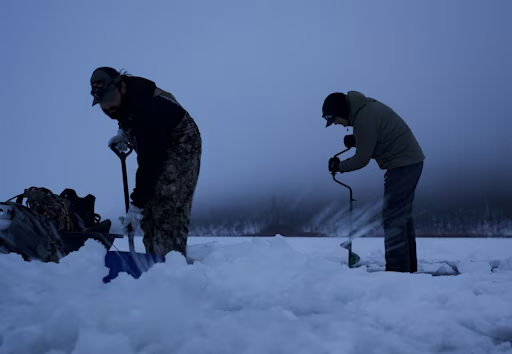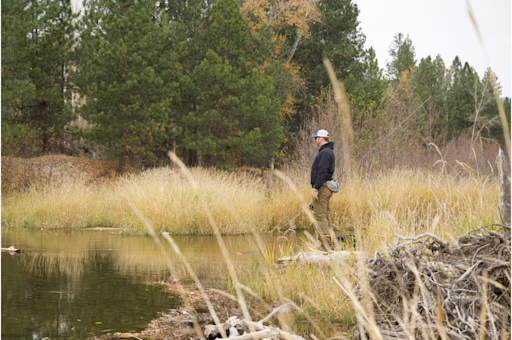Fishbrain functions built for spring
We look at the best Fishbrain functions to help you with the unpredictability of spring fishing.
Share this article

Spring brings unique challenges to fishing. Changing weather, water fluctuations and temperatures are just a few of the conditions you need to prepare for to find success.
Below we are going through some of the most important app functions on Fishbrain that every spring angler can use to overcome unpredictable conditions and find success to start the year.
Find new water fast

Sometimes, the water is just too high, too dirty, too un-fishable and you have to move spots. Anglers often don't have all the time in the world for our precious fishing days and when you need to move spots you need to move fast. The solution is at the tip of your fingers. When you open the Fishbrain Map you can tap on the water tab in the bottom left corner. From there you will get a list of every water near you and how far away it is.
You will see the number of catches logged on each water as well. From there, you can filter the water search by specific species, trophy catches, seasonal catches and more.
If you have smallmouth bass on the brain, the water tab will only show you bodies of water with those species in them. This works in reverse as well. If you're sick of by catching smaller species like sunfish, and bluegill find where these fish are caught most and avoid it. Or if you're interested in a mix bag catch, filter several species and find where they are all caught.
The fish quality gauge can be found next to the photo of each water and will show you how each water is fishing within the last week, allowing you to find the best producing water first.
Find high water fishing spots with your map

Rising water levels due to rain and snowmelt can leave your favorite holes covered in deep, muddy water and fast currents. You need a solid backup plan, during the spring runoff in the form of river braids and highwater inlets.
When you jump on your Fishbrain Map you can find these braids and inlets around reasonable access points. These act as spillways for high water. During summer these spots will have little to no water worth holding fish, but in spring the flood waters fill these places early and attract fish into the new habitat.
The more braids in a river, or the higher the inlet means the more water can be dispersed. So make sure and check for different areas that are suitable for different levels of flooding and fish them as the water progressively gets higher.
You can even turn on the Catches Layer on your map and filter those catches to spring to see if any other anglers have had success fishing these high water spots at the same time of year.
Watch the highs and lows on your gauges

Water levels go crazy in spring. A heavy rain, followed by a cold snap will have your water levels rising and falling, when what you really need to fish is some sort of consistency. Gauges are your best friend in these situations and you need to be watching them daily.
You can find gauges on your map with the Gauges Layer , found on the right side of your map screen. When on, you can find gauges for rivers and creeks anywhere in the country.
In mountainous regions, pay close attention to gauges after cold snaps. If the rivers are high, but you get a night of temperatures well below freezing, watch the river levels the next day as the cold will refreeze the snow, halting the flow of water feeding into the river, or creek.
You should also pick several gauges to monitor on different sections of river. Dams, creeks, irrigation ditches and other factors can make drastic differences in the amount of water dispersing through a river. Your local section could be completely blown out, while a section 10, or 20 miles upstream could be at the perfect level.
Watch the weather changes and react accordingly

Weather can change at the drop of a hat in spring and you have to expect every weather condition possible. Watch the weather on the app by the hour and check which conditions you can expect as the day progresses. Preparation is key this time of year and knowing the forecast before you head out is the only way to make sure you pack any extra jackets, insulation layers, or other gear.
Wind patterns can especially be volatile in the spring and watching the gusts and the directions of the wind on the app can help you decide which side of a body of water to fish so you can have the wind at your back and not casting into it.
See what’s working and what’s being caught now

The fluctuations in weather, water temperature and flow rates can have a drastic effect on which baits and lures are going to turn the most fish heads. As a fly angler in Montana, for example, spring can mean world famous dry fly hatches, streamer fishing, or nymphing and the hot fly can change day to day. Anglers need to be ready to pivot regardless of where, or how they fish.
Catch Filters on Fishbrain can help you see what’s being caught and what they’re being caught on, in your area, recently.
To filter your catch results, simply tap the filter icon at the top center of your map screen. You can select catches all the way down to 30 days ago. This will weed out any catches from other years and focus on the fish being caught now with the current weather patterns and water trends.
It's also important to check these catches for the baits, lures, hook sizes and other gear being used as fickle fish may change their preferences by the week, or even day.
Find new access and find that new honey hole

Access is the number one factor to consider when the spring water levels flood you out of your favorite spots. What kind of land is standing between you and that perfect piece of water that looks fishable?
Fishbrain’s brand new “Parks and Government Lands” map layer will highlight state or federally owned lands that may be used for public access. A quick tap on of these lands highlighted in beige, will reveal the name of the property, or access point, allowing you to plan your next trip, or do further research about the area’s accessibility.
State Parks, National Forest, National Park boundaries, fishing access sites, BLM land and more can be found on this newest layer, unlocking fishing possibilities you may have never even thought of before.
The Parks and Government Lands Layer is found on the Layers section of your map and you can access this layer by tapping the icon in the top corner of your map screen.
Don't be caught unaware or unprepared this spring, when conditions take a hard U turn. Make Fishbrain is with you for every step and every cast to work around these changes and take full advantage of spring fishing.
Now let’s go fishing. We can both bring the best fishing app for spring fishing.
If you haven't experienced the #1 fishing app worldwide, make sure and check out Fishbrain to see all the fish data, fishing spots, weather conditions you've been missing out on plus much more.

Download the Fishbrain app and access the best fishing spots in your area
Related blog posts
Master the hardwater season with advanced ice fishing tips . Learn how to find fish faster, refine your search and adjust presentations to catch more fish all winter long.

Your guide to Victoria’s best fish to catch in rivers, lakes, and coastal waters. Learn prime species, fishing tips, and key regulations

Learn how fish adapt as water temperatures cool from autumn to winter, including changes in behavior, metabolism, and habitat that help them survive.




